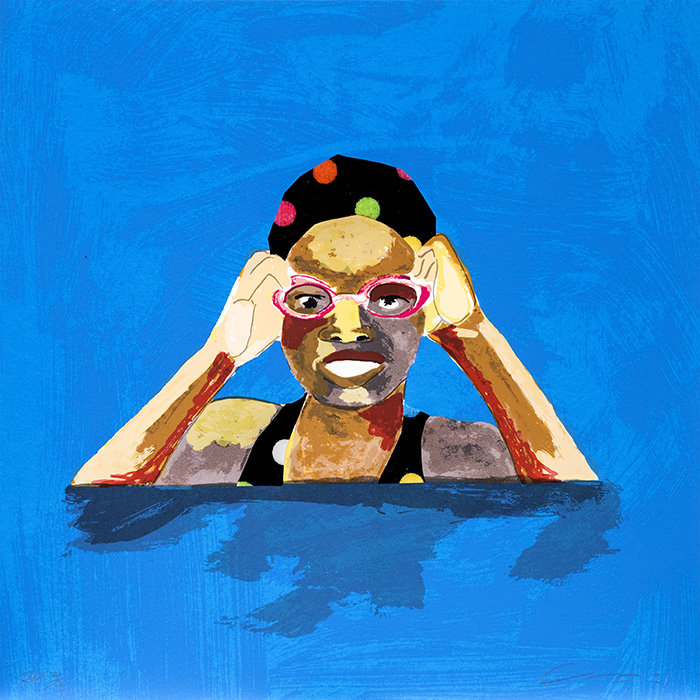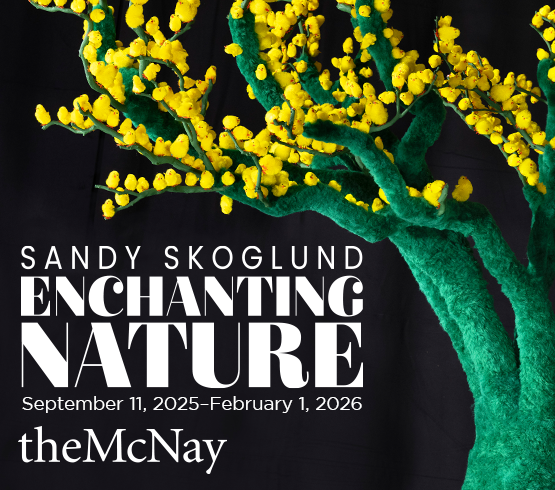The McNay Art Museum in San Antonio is using the recent acquisition of two important print suites as impetus to explore the diverse visions of three contemporary Black artists: Radcliffe Bailey, Kara Walker and Derrick Adams. On view through March 17, 2024, Prints and Drawings by Contemporary Black Artists sets up a kind of art conversation between these artists whose work has never been juxtaposed in this way.
Along with sharing these new print acquisitions with McNay visitors, the exhibition showcases the breadth of subject matter and themes in these three artists’ work. “We wanted to be sensitive to the fact that Black artists do not speak with a single voice,” states Williams. “We wanted these three artists included because they represent different points of view.”
The three are not necessarily known foremost as printmaking artists. Bailey, who tragically passed away in November of 2023, created collage paintings and sculptures. Walker’s use of black paper silhouettes in murals, film and large-scale installations to tell narratives that shock and disturb has earned her acclaim, controversy and solo exhibitions nationally and internationally. A painter and sculptor, Adams’ most recent project was to create a fully functional children’s playground as an installation for an art exhibition on the U.S. National Mall.
Radcliffe Bailey is an example of an artist who, once introduced to printmaking, spent time experimenting and began a new chapter in his work.
“There are certain rules you have to follow and certain techniques you must master in order to create the final image. A lot of artists really respond to that. Working within those strictures can create really beautiful work,” says Williams.
And that beautiful work can take very different forms with different subject matter.

1 ⁄3
Kara Walker, Sheet from Testimony, 2005. Photogravure. Collection of the McNay Art Museum, Museum purchase, 2022.16.2. © Kara Walker

2 ⁄3
Radcliffe Bailey, Between Two Worlds, 2003. Aquatint, etching, drypoint, photograph, chine-collé, and velvet. Collection of the McNay Art Museum, Gift of the Friends of the McNay, 2006.59. © Radcliffe Bailey

3 ⁄3
Derrick Adams, Sheet from How I Spent my Summer, 2021. Screenprint. Collection of the McNay Art Museum, Museum purchase, 2022.13.3. © Derrick Adams
“This is the public’s first opportunity to see the Derrick Adams, which are these incredibly brilliantly colored [prints] of people enjoying a pool.”
Williams says Walker’s silhouettes harken back to classic forms of shadow puppetry and 18th century silhouettes portraiture, but the stories those silhouettes tell will be very different from the scenes of joyous Black life in Adams’s prints.
“There’s something about her work when you first look at it that seems oddly familiar, and then you start looking at it more closely and it becomes a lot more disturbing.”
Set together in the same gallery, visitors will likely see a great range of points of view, yet those points do sometimes connect.
“They all are investigating the same question of: What does black art look like? And they all have different ways of portraying that.” Stressing the conversational dynamic, Feyock adds, “Our visitors will be able to pick up on how these works are talking to each other.”
Williams emphasizes the importance of representation in the collection especially for San Antonio. “When our visitors come they do see representation of their community on the walls, as well as seeing great works by Picasso, Van Gogh, Cézanne and others. It’s all of a whole.”
—TARRA GAINES





